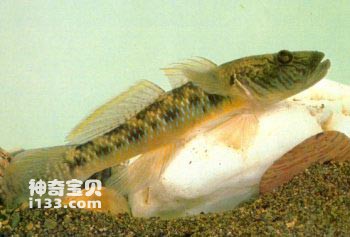Ctenogobius giurinus belongs to the order Perciformes, family Ctenogobius, subfamily Ctenogobius, and genus Ctenogobius. Commonly known as: Lushan Stonefish (Jiujiang County, Jiangxi), Spring Fish (Yangxin County, Hubei), Maiyu (Dongzhi County, Anhui), Qinyu (Jingxian, Anhui), the ancient name: Shajiu. English name: Barcheek goby.
The body is slender, rounded at the front, flattened at the back and flat on the head. The snout is long, the mouth is wide and large, the lips are thick, and the upper and lower jaws have several rows of fine, downy teeth. The muscles on the front operculum are well developed. The head is covered with scales, and the chest and abdomen are exposed and scaleless. The two dorsal fins are not connected, the front dorsal fin is composed of hard spines, and the back dorsal fin is composed of soft rays. The pelvic fins merge into a sucker-like shape on the thorax. The body color of the juvenile fish is slightly white, and when it grows to about 3 cm, pigment begins to appear. The body color of the adult fish is dark gray, with 4 wide black forked stripes across the back and spreading into irregular black spots on the sides.

Ctenopharyngodon fish likes to live in ponds, lakes, shallow water areas of small rivers and mountain streams with sandy soil, gravel, clear water and rich oxygen content. They usually live scattered in stone crevices, clinging to the stone walls with their powerful sucker-like pelvic fins, and only come out of the stone crevices when looking for food. Adult fish like to jump, sometimes jumping out of the water, sometimes jumping from one stone to another. Goby fish reach sexual maturity in the winter. From April to May every year, the broodstock begin to swarm. Male and female fish play and chase each other for reproductive activities. The female fish turns over the sand with her fins and lays her eggs in the sand cave. Juvenile fish of 1-2 cm like to swim in groups against the current. Whenever after a heavy rain, within two or three days of flash floods, the water temperature rises above 22°C, and when the floodwaters rise sharply and turn clear, and the flow speed accelerates, it is easy for the young fish to flock from the lake into the small river during the day, and gather together with the young fish in the river. They work their way upstream against the current on both sides of the river, constantly devouring aquatic insects and plankton washed down from the mountain streams. At night, they sink to the bottom of the water and cling to gravel with suction cups or hide in cracks in rocks to rest. Adult fish above 4 cm are less likely to swim in groups. Although the comb goby is small, it is extremely greedy and ferocious. It often attacks and devours smaller benthic fish, or uses its pectoral fins to dig and stir up the bottom sediment to find benthic invertebrates for consumption.
Ctenopharynx goby is widely distributed in various water systems from the Yangtze River to the Pearl River, but it only constitutes a fishery in the middle and lower reaches of the Yangtze River. Ctenopharyngodon fish with commercial value refers to 1-2 cm long juvenile fish. Shahe, Jiujiang County, Jiangxi Province is located at the foot of Mount Lushan. The ctenophorus tiger fish produced in Shahe is as famous as Mount Lushan due to its special shape, delicious taste and unique flavor, so it is named "Lushan Stonefish". The ctenophorus goby in Fushui River in Yangxin County, Hubei is called "spring fish" because its fishing season is in late spring and early summer when flowers are in bloom. The Zhangxi area in Dongzhi County, Anhui Province is called "wheat fish" because it is caught during the wheat harvest season and looks like wheat. There is a legend in Jingxian County, Anhui: As far back as the Jin Dynasty, a hermit named "Qin Gao" came to the Lion Stone Cave with craggy rocks to refine elixirs. When the elixir residue was thrown into the stream, it turned into a small elixir with "tiger head and snake tail". Fish, since then, every midnight, there is the clang of the piano in the gurgling water. Later, people named this stream "Qinxi", and the small fish in the stream was also named "Qinyu". Since ancient times, stone fish, spring fish, wheat fish and piano fish have all been listed as tributes, so they are also collectively called "tribute fish".
Except for eating stonefish fresh, all stonefish are commercially available as dried products. The usual preparation method is: wash and dry the fish, put it in a pot, bake it over a slow fire, and stir-fry it in a small amount of cooking oil. When it turns golden brown, take it out, dry it for another day, and then bag it and put it on the market. Every 5 kilograms of fresh fish can be processed into 1 kilogram of dried fish. The cooking methods of dried fish are mostly soaking and then frying eggs, steaming eggs, boiling soup or boiling briefly and adding sesame oil and soy sauce before serving as a cold dish. It has always been regarded as a delicacy at the banquet. In the Qinxi area of Anhui, it is also a precious tea treasure. Every year before and after the Qingming Festival, the local people cook the small fish caught in salted boiling water (along with fennel, tea, sugar and other condiments) and dry them over charcoal fire. After the dried fish is made, it still maintains a lifelike state: wide mouth and slightly open. , small eyes wide open, fins and tail curled suddenly. Making tea with harp fish is like fresh fish swimming around in the cup. It has a refreshing fragrance and a unique taste.
animal tags:
We created this article in conjunction with AI technology, then made sure it was fact-checked and edited by a Animals Top editor.